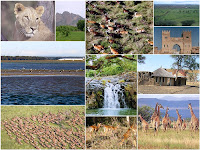Dinder National Park Sudan
 |
| Dinder - Sudan |
The Dinder National Park (DNP) was established in 1935 following the London Convention of 1933, and in 1979 it was designated as Biosphere Reserve, one of only two in the Sudan. The global significance of the DNP is that it falls between two important ecological zones the (Sudano–Sahelian and the Ethiopian). The Park has important wetland areas (mayas) and it is located in the flyway of migratory bird species from Eurasia to Africa. The DNP will be designated as a Ramsar site.
The annual rainfall in the Park ranges between 600-800mm and there are three major ecosystems: the riverine (Hyphaena thebaica, Acacia nilotica), the woodland (Acacia seyal, Balanites aegyptiaca), and the mayas and depressions. The mayas are oxbow lakes along the meandering rivers. They are subject to floods and contain green fodderand water up to the end of the dry season. The Park supports 27 large mammal species, bats and small mammals, more than 160 species of birds, 32 fish species, reptiles and amphibians. In addition there are about 58 species of shrubs and trees (Higher Council for Environment and Natural Resources, 2001).
The main threats facing the park could be summarized as follows: the absence of proper land use plans in the three states surrounding the Park; ever increasing size of populations in the Dinder area; the absence of a management plan for the Park; and the trespassing of pastoralists. The pastoralists are forced to enter the Park in spite of the present law protecting the Park. That law allows the court to confiscate half the number of any herd caught inside the Park. Current policies in the Sudan as a whole favor crop cultivation at the expense of other land uses, especially pastoralist. The last decades have witnessed a large expansion in mechanized rain-fed agriculture, with a devastating effect on rangeland, forests and wildlife areas. A lot of conflicts have ensued between the farmers and the pastoralists, who were even denied adequate stock routes to facilitate their trekking between the dry and the wet season ranges. Conflicts also occur between the pastoralists and the Park authorities, resulting sometimes in violent confrontations.
 |
| Dinder National Park - Google Map |
Dinder is mainly and extensively made of Savannah grassland, woodland and riverine forests; with a few hills and highlands located along and near the Ethiopian border. The park has three ecosystems, each with its own plant and animal communities. The northern part is dominated by acacia seyal and balanites aegyptiaca savannah which merges with anogeissus - combretum woodlot. Along the Dinder river doom palm (hyphaena thebaica) are dominant. Palm trees have an important economic value in the cottage industry as they are used in the making of mats, baskets, brooms; and are also used for construction. Other trees abundantly found in Dinder include: acacia siberana and tamorindus indica. Along the banks of the river, reeds and tall wild sorghum grass grow.
 |
| Dinder - more here |
Warthogs are common and can be found tilling the soil in search of tubers and roots. Hares and squirrels are restricted to the marginal parts of the park. Colorful sparrows, marabou stocks and pelicans are commonly seen near the ponds. Reportedly, there are 27 types of mammals in the park and 200-250 species of birds; and many reptiles, fish and other animals. Dinder, also, has extensive wetlands and ponds formed after floods (locally known as mayas) which have waterfowl such as: ducks, tree ducks, yellow-billed storks, ibises, egrets, guinea fowls, pelicans, vultures, kingfishers, crown cranes and herons. Many species which were originally abundant - due to poaching, lack of proper management and conservation planning and measures - have been exterminated. The black rhino and hippopotamus were last seen at the beginning of the century. The Nile crocodile was abundant until the 1940's but is very rarely seen today. The sommering's gazelle which used to migrate to the park, on and off, became extinct in 1970. The giraffe disappeared in 1985. The number of tiang (an antelope) is so greatly reduced that they might soon disappear. Expansion in mechanized rain-irrigated farming, recurrent droughts, wars, conflict and instability - have been very destructive and disastrous for the park. Due to Sudan's continuous strife, a large number of displaced people, now in their tens of thousands, have settled along the borders of the park, especially along the Rahad river.
 |
| Dinder Wetlands or mayas |
Like Radom (Al Radom) National Park, Dinder very much needs proper management and serious conservation and protective measures. It needs regular, well managed patrols, monitoring and assessment. As with all wildlife habitat areas in Sudan, Dinder National Park needs good tourist promotion and facilities. It is tourists who would earn much needed foreign currency who will ensure the continued existence of the park. Dinder, needs too, much more investments in the tourism industry - financial, material, much better infrastructure and many more, well trained personnel - to both serve in the tourist industry and to protect its wildlife. Like with Radom and almost all the country's wildlife reserves: all unlicensed firearms in the country should be collected. Poaching should be stopped. Hunting should be banned. And above all: to benefit and profit from what remains of its wildlife, Sudan needs security and stability.
+ Read this: Wetlands report
+ Read this report by UNEP
+ Read this report by FAO
+ Dinder: Biosphere Reserve Information
+ For more on Dinder go to: Earthlore
+ Images: Google

